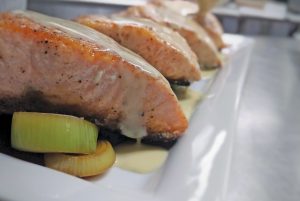 By Paul Suplee,
By Paul Suplee,
MBA, CEC, PC-3
(June 1, 2023) The banana palms are taller than I am, and as I write this, we are one day shy of June. This is unheard of, but we had an incredibly mild winter, so my little babies sprouted early and will be furnishing me with plenty of leaves to play with all season.
Be that as it may, can we please get a full stop to these cloudy, rainy, chilly, mucky days? Enough is enough and it’s time for me to start complaining about how hot it is! Good lord, make up your mind. I’ve even had a few fires in the fireplace this spring, something that I don’t remember ever doing. At least the house is warm and smells great.
And while the weather is chilly, I can slide this dish in one more time. Since I stay away from uber-buttery sauces when it’s hot, I’ll sneak a few more in before the weather finally breaks. And I’ll start with sauce beurre blanc.
Beurre blanc is a sauce to die for, or more grammatically, the sauce for which one would happily perish. That doesn’t roll off the tongue quite as nicely as our first rendition, so we’ll stick with that instead. Sometimes I don’t understand all our American colloquialisms, but I simply have to roll with it.
I should probably get back on track before I completely go off the rails.
As I work my way through the molding of young and old minds in the ways of the kitchen, I typically start with the Mother Sauces. These include hollandaise, velouté, bechamel, espagnole and tomato. After these ubiquitous sauces, I go to the cold sauces such as mayonnaise (students love when I call hollandaise “hot mayo. It just sits wrong with some) and emulsified dressings.
Then, it’s off to the races with Latin salsas, Spanish, French and Italian sauces, and then some of the sauces of Asia. One could make a study of sauces and there is no end game in the study of them. Personally, I lean toward chopped herb & vinegar/citrus sauces such as chimichurri or gremolata, and I am restarting my potted herb garden so I can enjoy them all summer long.
But sometimes it serves me well to go back to the classic sauces, if for nothing else than just to play around. Hollandaise is always fun to make, and while I enjoy a good eggs Benedict or a steak with a side of bearnaise (hollandaise with a shallot/tarragon reduction), that can be a bit heavy.
Sauce beurre blanc (white butter sauce) is equally as calorically dense, but for some reason it is bright and succulent. Putting this on seared salmon is honestly the best application I can think of. The sauce is light enough to serve with seafood, and at the same time rich and tangy enough to stand up to a high-oil fish such as salmon. Even if you skin the salmon, you can fry up the skin and make little ‘bacon strips’ as a garnish and the sauce will stand up to them as well.
So, go enjoy the season and the palms, sear the salmon, make the sauce and while it is a sauce to die for, don’t be that dramatic. It’s good, but it’s not that good.
Oh, that Beurre Blanc!
serves 4
½ c. Chardonnay or other dry white wine
Juice of 1 lemon
3 ea. Medium, finely diced shallots (they will be strained out later)
½ c. Heavy cream, 40% if possible
½ Lb. Unsalted Irish butter, cut into 1” cubes.
Salt & Pepper, as needed
4 5-ounce seared salmon filets
Braised Leeks (Recipe follows)
- Place the wine, juice and shallots in a saucepan and bring to a low boil
- Reduce until it has a syrupy consistency, but be careful that it does not change color too terribly much. This could mean that it has burnt the sugars a little too much
- Add the cream and reduce again to thicken
- Pull off the heat (*critical part of making this sauce) and add the cold butter cubes a few at a time, swirling until melted and incorporated in the sauce
- Season to taste and set aside. With the heavy cream as an addition, it will keep without breaking for a few hours. Use in one sitting, as it typically will break if cooled and reheated
- Serve with Seared salmon and braised leeks, and relish in one of the finest sauces you will ever experience
Braised Leeks
serves 4
2 oz. Unsalted Irish butter
1 bunch leeks, washed and cut into ¾” discs
3 cloves garlic, minced
2 c. Vegetable or chicken stock
S&P as needed
- Heat butter in a pan large enough to hold the leeks but small enough to allow the stock to come at least halfway up
- When the foaming subsides (which means that the water has cooked out of the butter), add the leeks and cook briskly for about 1-2 minutes, or until there is a little bit of color on them. You are not sautéing these, so just go for a little color
- Reduce the heat and put the stock on the leeks
- Bring the stock to a low simmer and cover the pot
- Cook for about 25 minutes, or until the leeks are tender
- Pull from the liquid and keep warm until service
Paul Suplee is the owner of the boxcar restaurants and also
Senior Lecturer of Culinary Arts at UMES. boxcarrestaurants.com
